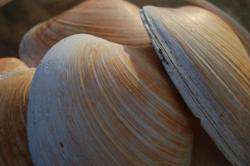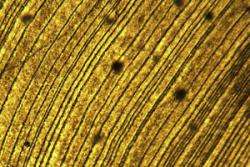Longest-lived animals reveal climate change secrets

(Phys.org) -- Researchers at Bangor University have used some of the world’s longest-lived animals to look at how the North Atlantic Ocean has affected our climate over the past 1,000 years.
By looking in great detail at the shell of a species of clam that can live for at least 500 years, they have shown that a weakening of the Gulf Stream – the current that brings warm water from the Caribbean to northwest Europe - may have contributed to exceptionally cold conditions in Europe from the 15th to the 19th centuries. This is the period known as the Little Ice Age, and it was a time of bitter cold, poor harvests, famines and revolutions, but also of spectacular ice fairs on the frozen River Thames.
“If the Gulf Stream is weaker, then less heat is being transported north, so that temperatures in northwest Europe became more like temperatures at the same latitude in Canada”, said Dr. Paul Butler of School of Ocean Sciences at Bangor University.
The research, published in the leading journal Nature Communications, uses radiocarbon analysis of the shells – which come from animals that lived north of Iceland - to work out the source of the water in which the clams were living. “The radiocarbon tells us how long it has been since the last time the water was at the surface,” said Dr. Butler. “If the water is ‘old’, we know that it originated deep within the Arctic Ocean. On the other hand, Atlantic sourced water, like the Gulf Stream, was at the surface more recently, so it is expressed in the shells as ‘young’. During the Little Ice Age, the older Arctic water seems to have been dominant north of Iceland, and there was less Atlantic-sourced water. We interpret this as meaning that the Gulf Stream was weaker. Before the 15th century – in what we call the Medieval Warm Period – the situation was reversed.”

The announcement by Bangor scientists in October 2007 of the remarkable lifespan of these clams generated worldwide interest and achieved a place in Time magazine’s ten most significant scientific discoveries of the year. The latest results show how this field of research can be used in the study of the marine environment of the past.
“The nice thing about these shells is that they have distinct annual growth lines, so we can accurately date the shell material”, said Dr. Butler. “What makes them even more useful is that the lines have the same patterns throughout the population, so by comparing patterns in dead shells with patterns in shells from live animals, we can work out the dates of the dead shells. That’s just the same as what archaeologists do when they use tree rings in dead wood to work out the dates of old buildings.”
Journal information: Nature Communications
Provided by Bangor University



















